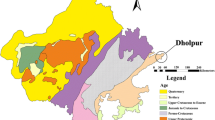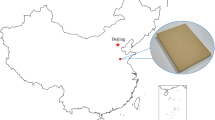Abstract
Seven German and three Hungarian monumental sandstones have been tested in laboratory conditions to analyse the effect of heat. The studied quartz sandstones have a wide-range of cements and grain-sizes including silica-, carbonate-, clay- and ferrous mineral—cemented varieties of fine-, medium- to coarse-grained types. Cylindrical specimens were heated up to 150, 300, 450, 600, 750 and 900°C in an oven. The mineralogical and textural changes were recorded and compared by using microscopy, XRD, DTA-DTG and SEM. Colours and colour differences (a*, b*, L* values) were also measured and evaluated. Colour changes are related to mineral transformations. The most intense colour change is caused by the oxidation of iron-bearing minerals to hematite that takes place up to 900°C. When temperature increases the green glauconite becomes brownish while the chlorite changes to yellowish at first. The colour of burnt sandstone is not a direct indicator of burning temperature, since there are sandstones in which the burnt specimens are lighter and less reddish than the natural ones. Porosity increase is related to micro-cracking at grain boundaries (above 600°C) and within the grains (at and above 750°C) and mineral transformations. The clay mineral structure collapses at different temperatures (kaolinite up to 600°C, chlorite above 600°C) and leads to a slight increase in porosity. The most drastic change is observed in calcite cemented sandstones where the carbonate structure collapses at 750°C and CaO appears at 900°C. Subsequently it is transformed to portlandite due to absorption of water vapour from the air. This leads to the disintegration of sandstone at room temperature a few days after the heat shock.















Similar content being viewed by others
References
Allison RJ, Bristow GE (1999) The effects of fire on rock weathering: some further considerations of laboratory experimental simulations. Earth Surface Processes and Landforms 24:707–713
Allison RJ, Goudie AS (1994) The effects of fire on rock weathering: an experimental study. In: Robinson DA, Williams RBG (eds) Rock Weathering and Landform Evolution. Wiley, Chichester, pp 41–56
BRE (1945) Repair of Damaged Buildings—the repair of stone-work damaged by fire. Garston Building Research Establishment Note 21: 1–5
Chakrabarti B (1993) An assessment of effects of fire damage to stone in buildings & procedures for restoration and conservation of stone in some historic stone buildings. Building Research Establishment Note 93(15): 2–14
Chakrabarti B, Yates T, Lewry A (1996) Effect of fire damage on natural stonework in buildings. Construction and Building Materials 10: 539–544
Dorn RI (2003) Boulder weathering and erosion associated with a wildfire, Sierra Ancha Mountains, Arizona. Geomorphology 55:155–171
Fitzner B, Heinrichs K, La Bouchardiere D (2003) Weathering damage on Pharaonic sandstone monuments in Luxor-Egypt. Building and Environment 38: 1089–1103
Goudie AS, Allison RJ, McClaren SJ (1992) The relations between modulus of elasticity and temperature in the context of the experimental simulation of rock weathering by fire. Earth Surface Processes and Landforms 17:605–615
Grimm WD (1990) Bildatlas wichtiger Denkmalgesteine der Bundesrepublik Deutschland. Arbeitshefte der Bayerishe Landesamtes für Denkmalflege 50, pp 132–163
Hajpál M (1999) Behaviour of sandstones of historical monuments under thermal influence Periodica Polytechnica 43(2): 207–218
Hajpál M (2002a) Changes in sandstones due to thermal effect. Unpublished PhD thesis (In Hungarian with English and German abstract), Budapest University of Technology and Economics, Budapest
Hajpál M (2002b) Changes in sandstones of historical monuments exposed to fire or high temperature. Fire Technology 38(4): 373–382
Hajpál M, Török Á (1998) Petrophysical and mineralogical studies of burnt sandstones. Proceedings 2nd international PhD Symposium 1998 Budapest: 476–485
Harold RW (2001) An introduction to appearance analysis. Second Sight 84:1-7
Kieslinger A (1932) Zerstörungen an Steinbauten, Franz Deuticke, Leipzig und Wien, pp 389–426
Kieslinger A (1949) Die Stein von St. Stephan, Harold Verlag, Wien, pp 20–25
Pettijohn FJ, Potter PE, Siever R. (1987) Sand and sandstone. Springer Verlag, New York
Sharma A, Goike T (2003) CIELAB: Measuring colour on many different media. American Printer, Primedia: 1–4
Smith BJ, Turkington AV, Warke PA, Basheer PAM, McAlister JJ, Meneeley J, Curran JM (2002) Modelling the rapid retreat of building sandstones. A case study from a polluted maritime environment. In: Siegesmund S, Volbrecht A, Weiss T (edsEds.) Natural stones, weathering phenomena, conservation strategies and case studies. Special Publications 205, Geological Society, London, pp 347–362
Wenzel F (1993) Der Wiederaufbau der Frauenkirche zu Dresden. Sonderdruck aus Bautechnik 70:1-16
Acknowledgements
The financial support of OTKA Postdoctoral Fellowship project no. D 45932 (MH) and Széchenyi Fund (ÁT) are appreciated.
Author information
Authors and Affiliations
Corresponding author
Additional information
Special issue: Stone decay hazards
Rights and permissions
About this article
Cite this article
Hajpál, M., Török, Á. Mineralogical and colour changes of quartz sandstones by heat. Env Geol 46, 311–322 (2004). https://doi.org/10.1007/s00254-004-1034-z
Received:
Accepted:
Published:
Issue Date:
DOI: https://doi.org/10.1007/s00254-004-1034-z




